
Isopoda is an order of crustaceans that includes woodlice and their relatives. Isopods live in the sea, in fresh water, or on land. All have rigid, segmented exoskeletons, two pairs of antennae, seven pairs of jointed limbs on the thorax, and five pairs of branching appendages on the abdomen that are used in respiration. Females brood their young in a pouch under their thorax.

Cymothoa exigua, or the tongue-eating louse, is a parasitic isopod of the family Cymothoidae. It enters fish through the gills. The female attaches to the tongue, while the male attatches to the gill arches beneath and behind the female. Females are 8–29 mm (0.3–1.1 in) long and 4–14 mm (0.16–0.55 in) wide. Males are about 7.5–15 mm (0.3–0.6 in) long and 3–7 mm (0.12–0.28 in) wide. The parasite severs the blood vessels in the fish's tongue, causing the tongue to fall off. It then attaches itself to the remaining stub of the tongue and becomes the fish's new tongue.

The Cape triplefin, Cremnochorites capensis, is a triplefin blenny of the family Tripterygiidae and only member of the genus Cremnochorites, found in the western Indian Ocean and southeast Atlantic, from Sodwana Bay to False Bay in South Africa. It reaches a maximum length of 8 centimetres (3.1 in). It is found below the low tide mark down to 30 metres (98 ft) on rocky reefs.

The Cape elephantfish, josef, or St Joseph shark is a species of fish in the family Callorhinchidae.

The Cymothoidae are a family of isopods in the suborder Cymothoida found in both marine and freshwater environments. Cymoithoids are ectoparasites, usually of fish, and they include the bizarre "tongue-biter", which attaches to a fish's tongue, causing it to atrophy, and replaces the tongue with its own body. Ceratothoa oestroides is one of the most devastating ectoparasites in Mediterranean aquaculture. Around 40 genera and more than 380 species of cymothoid are recognised. Species of the Cymothoidae are generally found in warmer waters and rarely in the cool and cold climates.

Cirrhibarbis capensis, the barbelled klipfish, is a species of clinid found in subtropical waters of the Atlantic Ocean around South Africa. This species can reach a maximum length of 36 centimetres (14 in) TL. This species preys primarily on benthic crustaceans, mostly amphipods and isopods. It is currently the only known member of its genus.

Clinus venustris, the speckled klipfish, is a species of clinid that occurs in subtropical waters of the Atlantic Ocean from Namibia to South Africa where it is found in the subtidal zone as well as being a denizen of tide pools. This species can reach a maximum length of 12 centimetres (4.7 in) TL. and feeds primarily on amphipods, isopods, mysids, and echinoderms.

Aega psora is a species of isopod crustacean that parasitises a number of fish species in the North Atlantic. It is a serious ectoparasite of larger species of fish, particularly when they are injured.
Cymothoa elegans is a species of parasitic isopod in the genus Cymothoa. It has rarely been recorded, with all records coming from the north coast of Java. They are in the arthropod phylum and can more closely be classified as crustaceans.

Genypterus capensis, commonly known as kingklip, is a species of cusk eel occurring along the Southern African coast from Walvis Bay in Namibia to Algoa Bay in South Africa, and is closely related to Genypterus blacodes from New Zealand. The species grows to a maximum length of 180 cm, a weight of 15.0 kg, and is one of the most popular fish items on South African menus. Despite appearances, it is not closely related to the eel family of Anguilliformes.

Myzostoma fuscomaculatum, the crinoid worm, is a species of marine worm in the family Myzostomida.

Cirriformia capensis, commonly known as the orange thread-gilled worm, is a species of marine polychaete worm in the family Cirratulidae.
Anilocra pomacentri is a species of marine isopod in the family Cymothoidae. It is found off the coast of eastern Australia and is an external parasite of the yellowback puller, a species of damselfish. The presence of the parasite on a fish causes a significant slowing of the growth rate and an increased mortality.

Pachymetopon blochii, the hottentot seabream or hottentot, is a species of sea bream in the family Sparidae, native to the southwestern coast of Africa.

Glyptidotea lichtensteini, the keeled isopod, is a medium-sized isopod in the family Idoteidae, found on the coast of southern Africa.

Exosphaeroma laeviusculum is a species of isopod in the family Sphaeromatidae, native to the west coast of southern Africa.

Elthusa californica is a species of isopod in the family Cymothoidae of the order Isopoda. E.californica is a saltwater parasitic isopod. Like many species of the Elthusa genus, E. californica was first placed in within the Liveneca genus, but later underwent taxonomic revisions.

The Helderberg Marine Protected Area is a small marine conservation area on the north-eastern side of False Bay in the Western Cape province of South Africa, It lies between the mouths of the Lourens River in the Strand, and the Eerste River in Macassar.

Ceratothoa oestroides is a crustacean isopod, obligate ectoparasite of marine fish that dwells in the buccal cavity. It is the causative agent of various pathologies including tissue damage at the parasitisation site (tongue), growth defects, decrease in mean host weight and size and increases mortalities in farmed and wild fish populations. It has been recorded in six different fish families: Sparidae, Carangidae, Clupeidae, Maenidae, Scorpenidae, and Mugilidae.

















